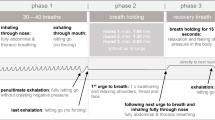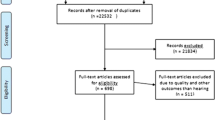Abstract
Background
Construction workers are at risk of noise-induced hearing loss (NIHL) but often have no periodic audiometric testing.
Methods
The participants were construction workers assessed for Hand-Arm Vibration Syndrome (HAVS) at the Occupational Health Clinic, St. Michael’s Hospital, Toronto, Ontario. Audiometry was offered and 169 of the 191 workers assessed for HAVS agreed to have the audiometric test. The objective was to examine the prevalence of hearing loss in these 169 workers and to determine the effect on hearing of duration of work in construction (as a proxy for noise exposure) and the severity of vibration white finger (VWF) which previous studies have suggested is a marker for increased individual susceptibility for NIHL. VWF was measured by the Stockholm vascular scale.
Results
All participants were men, median age of 57 (range: 28-75), median number of years worked in construction of 35 (range: 4-52). All of the Spearman rank correlations between years worked in construction and the hearing levels at each audiometric frequency were statistically significant (p<0.001). Overall, 31 (18.3%) participants had hearing loss at or above the level at which a workers’ compensation pension would be granted in Ontario and the prevalence of this auditory outcome had a statistically significant increase as years worked in construction increased. Multivariate linear regression indicated that VWF also had a statistically significant effect on hearing loss for all audiometric frequencies combined after controlling for years worked in construction.
Conclusion
Improved prevention of hearing loss in construction workers is needed.
Résumé
Contexte
Les travailleurs du bâtiment courent un risque de perte d’audition due au bruit (PADB), mais souvent ne se soumettent pas à des examens audiométriques périodiques.
Méthode
Les participants étaient des travailleurs du bâtiment évalués pour le syndrome vibratoire main-bras (SVMB) à la clinique de santé au travail de l’hôpital St. Michael de Toronto, en Ontario. Nous leur avons proposé un examen audiométrique, et 169 des 191 travailleurs évalués pour le SVMB ont accepté. Notre objectif était de déterminer la prévalence de la perte auditive chez ces 169 travailleurs, l’effet sur l’ouïe de la durée du travail dans l’industrie du bâtiment (variable substitutive à l’exposition au bruit) et la gravité du syndrome du doigt mort (SDM), lequel, selon des études antérieures, pourrait être un indicateur de susceptibilité individuelle accrue pour la PADB. Nous avons mesuré le SDM selon l’échelle de Stockholm pour les symptômes vasculaires.
Résultats
Tous les participants étaient des hommes d’âge médian de 57 ans (intervalle: 28-75) ayant travaillé 35 ans (nombre médian) dans l’industrie du bâtiment (intervalle: 4-52). Toutes les corrélations des rangs de Spearman entre les années de travail dans le bâtiment et le niveau d’ouïe à chaque fréquence audiométrique étaient significatives (p<0,001). Dans l’ensemble, 31 participants (18,3 %) avaient une perte auditive supérieure ou égale au niveau auquel l’Ontario accorde une rente accident du travail, et la prévalence de cette perte auditive augmentait de façon significative avec les années de travail dans le bâtiment. Une régression linéaire multivariée a aussi montré un effet significatif du SDM sur la perte auditive pour toutes les fréquences audiométriques combinées, en tenant compte des années de travail dans le bâtiment.
Conclusion
Il faut améliorer la prévention de la perte auditive chez les travailleurs du bâtiment.
Similar content being viewed by others
References
Kurmis AP, Apps SA. Occupationally-acquired noise-induced hearing loss: A senseless workplace hazard. Int J Occup Med Environ Health 2007;20(2):127–36.
Nelson DI, Nelson RY, Concha-Barrientos M, Fingerhut M. The global burden of occupational noise-induced hearing loss. Am J Ind Med 2005;48(6):446–58.
Tak S, Davis RR, Calvert M. Exposure to hazardous workplace noise and use of hearing protection devices among US workers-NHANES, 1999–2004. Am J Ind Med 2009;52(5):358–71.
Sinclair JDN, Haflidson WO. Construction noise in Ontario. Appl Occup Environ Hyg 1995;10(5):457–60.
Hessel PA. Hearing loss among construction workers in Edmonton, Alberta, Canada. J Occup Environ Med 2000;42(1):57–63.
House RA, Pasut G. Evaluation of the audioscope in an industrial setting. J Occup Med 1992;34(5):539–45.
Griffin MJ, Bovenzi M. The diagnosis of disorders caused by hand-transmitted vibration: Southhampton Workshop 2000. Int Arch Occup Environ Health 2002;75(1-2):1–5.
Bovenzi M. Health risks from occupational exposures to mechanical vibration. Med Lav 2006;97(3):535–41.
Noel B. Pathophysiology and classification of the vibration white finger. Int Arch Occup Environ Health 2000;73(3):150–55.
Palmer KT, Griffin MJ, Syddall HE, Pannett B, Cooper C, Coggon D. Raynaud’s phenomenon, vibration induced white finger, and difficulties in hearing. Occup Environ Med 2002;59(9):640–42.
Pyykko I, Starck J, Farkkila M, Hoikkala M, Korhonen O, Nurminen M. Handarm vibration in the aetiology of hearing loss in lumberjacks. Br J Ind Med 1981;38(3):281–89.
Pyykko I, Koskimies K, Starck J, Pekkarinen J, Farkkila M, Inaba R. Risk factors in the genesis of sensorineural hearing loss in forestry workers. Br J Ind Med 1989;46(7):439–46.
Iki M, Kurumatani N, Hirata K, Moriyama T. An association between Ray-naud’s phenomenon and hearing loss in forestry workers. Am Ind Hyg Assoc J 1985;46(9):509–13.
Miyakita T, Miura H, Futatsuka M. Noise-induced hearing loss in relation to vibration-induced white finger in chain-saw workers. Scand J Work Environ Health 1987;13(1):32–36.
Szanto C, Ligia S. Correlation between vibration induced white finger and hearing loss in miners. J Occup Health 1999;41(4):232–37.
Pyykko I, Pekkarinen J, Stark J. Sensory-neural hearing loss during combined noise and vibration exposure. Int Arch Occup Environ Health 1987;59(5):439–54.
Pekkarinen J. Noise, impulse noise, and other physical factors: Combined effects on hearing. Occup Med 1995;10(3):545–59.
House R. The effect of combined noise and vibration exposure on hearing. Occup Health Ont 1988;9(2):72–85.
Gemne G, Pyykko I, Taylor W, Pelmear PL. The Stockholm Workshop scale for the classification of cold-induced Raynaud’s phenomenon in the hand-arm vibration syndrome (revision of the Taylor-Pelmear scale). Scand J Work Environ Health 1987;13(4):275–78.
Noise-induced Hearing Loss, On / After January 2, 1990. Document No. 16-01-04. Toronto, ON: Workplace Safety and Insurance Board, 2008.
Guides to the Evaluation of Permanent Impairment, Third Edition (Revised). Milwaukee, WI: American Medical Association, 1990.
Tak S, Calvert GM. Hearing difficulty attributable to employment by industry and occupation: An analysis of the National Health Interview Survey-United States, 1997 to 2003. J Occup Environ Health 2008;50(1):46–56.
Arndt V, Rothenbacher D, Brenner H, Fraisse E, Zschenderlein B, Daniel U, et al. Older workers in the construction industry: Results of routine health examination and a five year follow-up. Occup Environ Med 1996;53(10):686–91.
Zhu S, Sakakibara H, Yamada S. Combined effects of hand-arm vibration and noise on temporary threshold shifts of hearing in healthy subjects. Int Arch Occup Environ Health 1997;69(6):433–36.
Malchaire J, Piette A. A comprehensive strategy for the assessment of noise exposure and risk of hearing impairment. Ann Occup Hyg 1997;41(4):467–84.
Shuter AH. Construction noise: Exposure, effects and the potential for remediation; a review and analysis. Am Ind Hyg Assoc J 2002;63(6):768–89.
Author information
Authors and Affiliations
Corresponding author
Additional information
Conflict of Interest: None to declare.
Rights and permissions
About this article
Cite this article
House, R.A., Sauvé, J.T. & Jiang, D. Noise-induced Hearing Loss in Construction Workers Being Assessed for Hand-arm Vibration Syndrome. Can J Public Health 101, 226–229 (2010). https://doi.org/10.1007/BF03404378
Received:
Accepted:
Published:
Issue Date:
DOI: https://doi.org/10.1007/BF03404378




